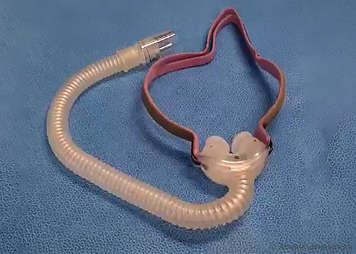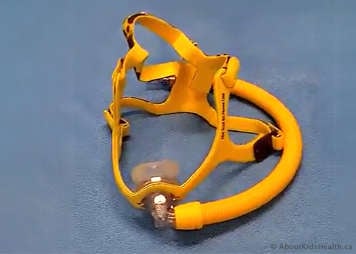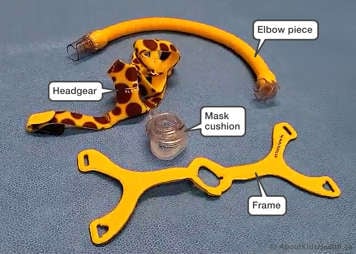There are three main types of masks:
- nasal pillow
- nasal
- full face - includes oronasal (covers nose and mouth) and total face mask (covers nose, mouth and eyes)



Nasal and full face masks are the most common types of masks used for children. Please talk to your health-care team to see which mask is most appropriate for your child.
A mask generally consists of three or four parts.
- mask cushion - this is the piece that sits directly on the face.
- headgear- this secures the mask to the face
- frame - connects the cushion and headgear.
- elbow piece - with or without a small piece of tubing

A well-fitting mask should fit snugly to the face but not too tight. You want to make sure there is no air leaking from around the cushion. You can adjust the headgear with the Velcro straps to ensure a snug fit. You should be able to fit two fingers under the straps to make sure it is not too tight. If your child experiences skin irritation or discomfort, contact your team for further support.
All masks should have an intentional leak. This is usually found on the elbow of the mask. A leak is necessary to allow your child to breathe out. Make sure you feel air flow here when the therapy is on and that the ports are not blocked. If you do not feel air flow, you may want to clean the ports with a toothbrush.
Full face masks have a safety valve since they cover both the nose and mouth. When the therapy is turned on, the safety valve is closed. If the therapy is accidentally disconnected or stopped, the airflow stops and the valve drops down allowing your child to breathe through the open valve.
Mask maintenance
How to clean and maintain your child’s mask and mask cushion
The mask and mask cushion should be cleaned daily by hand using water and a mild soap. A mild soap is one that does not contain emollients or antimicrobial ingredients. Rinse the mask and mask cushion thoroughly and let them air dry. Make sure the exhalation port is clear of debris or secretions. The mask should be replaced every 6 to 12 months or as indicated by the manufacturer.
How to clean your child’s headgear
Headgear needs to be washed by hand weekly basis using water and mild soap. Rinse the headgear thoroughly. Another option is to machine wash the headgear in a pillow case using similar mild soap on a gentle cycle. Hang to dry.